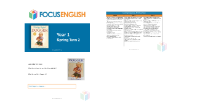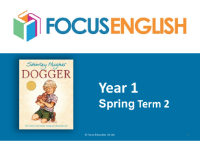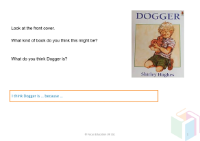Dogger - Learning Sequence

English Resource Description
The learning sequence for the children's book "Dogger" spans six weeks and is designed to enhance both comprehension and writing skills. In the first week, students identify and discuss unfamiliar words, adding them to a class dictionary or working wall. They make predictions about the story based on the front cover and begin reading, focusing on the meaning of specific words like 'fond'. A 'single bubble' activity helps them gather information about the character Dogger, and they write their own memories of fairs in a 'memory bubble'. The sequence continues with children bringing in their favourite toys, describing them orally, and practising sentence construction with conjunctions such as 'and' and 'because'. As they progress through the story, they discuss the plot, make predictions, and engage in activities like creating a lost poster for Dogger, ensuring they include important details and practice accurate sentence writing.
In the subsequent weeks, the children delve deeper into the narrative, exploring the setting of the summer fair and discussing the book's time period through the costumes depicted. They relate events in the book to their own experiences, such as participating in races, and role-play scenarios from the story to understand characters' feelings. The learning sequence includes predicting outcomes, discussing moral dilemmas, and sequencing events on a story map or timeline. Students retell the story using time adverbials and vocabulary related to feelings, with an emphasis on writing accurate, meaningful sentences. The unit concludes with a research project on toys from the past and present, where children write sentences about various toys, compare them, and proofread their work with a focus on clarity and coherence.



